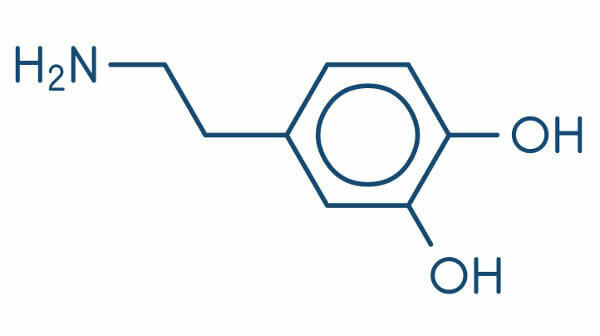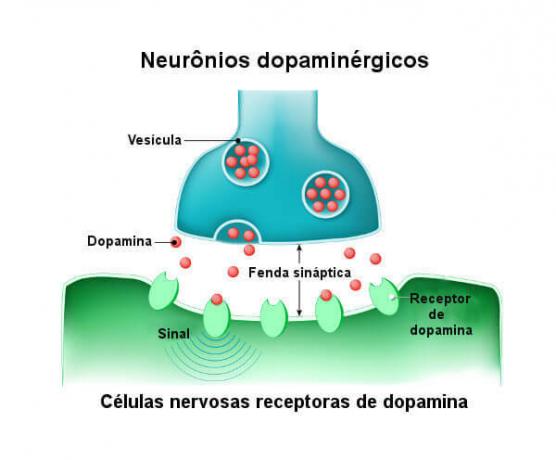THE dopamine it is an important neurotransmitter and acts on the central nervous system of mammals. When we say that a substance is a neurotransmitter, we are saying that it works as a chemical messenger, carrying information from a neuron to a receptor cell. It is noteworthy that dopamine was only considered as such from the 1950s.
Features
→ structural formula
Dopamine is part of the catecholamine family, which, in turn, are basically formed by a catechol (3,4-dihydroxybenzene), which is connected by an ethyl bridge to an amine group.

Look closely at the structural formula for dopamine, an important neurotransmitter.
→ Where is it produced?
Dopamine is synthesized in the cytoplasm of so-called neurons dopaminergics from an amino acid: tyrosine, which is initially converted to L-dopa through the action of tyrosine hydroxylase. Subsequently, L-dopa is converted to dopamine through the action of aromatic L-amino acid decarboxylase.
After being produced, dopamine is transported within vesicles. THE
dopamine release involves an exocytosis process, that is, dopamine is released through vesicles that fuse with the cell's plasma membrane and release the neurotransmitter out. Look the following picture:
Read too:exocytosis
dopamine function
This neurotransmitter is known to be involved with processes such as cmotor control, cognition, compensation, pleasure, mood and some endocrine functions, in addition to being a precursor of other neurotransmitters: norepinephrine and epinephrine (adrenaline).
Dopamine is also related to stimulation of renal sodium excretion, suppression of aldosterone release, relaxation of the esophageal sphincter, and delay in stomach emptying. Recent studies have also revealed that this substance has a role with regard to problems such as schizophrenia and Parkinson's disease (see more about the topic below). Based on this understanding, studies on this neurotransmitter were intensified.
Dopamine and addictive drugs
Dopamine is related to the so-called reward system, which is a neuronal circuit in the brain that directly influences our emotions. This system guarantees the motivation to perform certain activities, such as the feeling of happiness when we eat when we are hungry. When neurons in this system are activated, they release dopamine in specific regions of the brain, causing an increased sensation of pleasure.
Read too: Drugs: curiosities and harm of narcotics
Some drugs directly affect the reward system, causing an increase in dopamine activity. With the time of use of a given drug, there are changes in the long-term reward system. Thus, drugs such as cocaine and alcohol are addictive because their use is associated with these feelings of pleasure.
Dopamine and schizophrenia

Schizophrenia is related to dopamine levels in the brain.
THE schizophrenia is a disorder characterized mainly by the occurrence of episodes of psychosis, that is, in certain situations, the individual cannot separate real from unreal situations. This disease affects people of both sexes (usually those who are moving out of their teens and into their second decade of life).
One of the explanations for the occurrence of schizophrenia are alterations in the neuronal pathways that use dopamine as a neurotransmitter. This disorder is likely due to elevated or otherwise unregulated levels of dopamine in the brain. Therefore, treatment for schizophrenia includes drugs that block dopamine receptors.
Dopamine and Parkinson's Disease

Parkinson's disease is related to a progressive loss of neurons that produce dopamine.
THE Parkinson's disease affects the motor system, causing, among other symptoms, muscle tremors, abnormal slowness of movement, stiffness and change in balance, that can predispose the individual to falls. This disease is progressive and affects older people.
Parkinson's causes the death of neurons in the midbrain, which are responsible for releasing dopamine. This disease is therefore directly related to this important neurotransmitter.
Currently all Parkinson's treatments aim to remedy the symptoms, that is, they are not able to cure the patient, and they are based on restoring adequate amounts of dopamine to the brain.
By Ma. Vanessa Sardinha dos Santos
